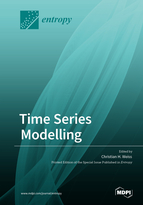Time Series Modelling
A special issue of Entropy (ISSN 1099-4300). This special issue belongs to the section "Information Theory, Probability and Statistics".
Deadline for manuscript submissions: closed (30 April 2021) | Viewed by 44104
Special Issue Editor
Interests: time series analysis; count time series; categorical time series; statistical process control; discrete data; computational statistics
Special Issues, Collections and Topics in MDPI journals
Special Issue Information
Dear Colleagues,
Time series consist of data observed sequentially in time, and they are assumed to stem from an underlying stochastic process. The scope of time series approaches thus covers models for stochastic processes as well as inferential procedures for model fitting, model diagnostics, forecasting, and various other applications. While time series data have been collected for a relatively long time in history (one may recall the famous time series on sunspot numbers), the development of methods and stochastic models for such time series is more recent. For example, the correlogram or the autoregressive and moving-average models for time series, which are currently part of any course on time series analysis and are covered by any statistical software, date back to only the 1920s, and thus will celebrate their 100th birthday in the upcoming years. Furthermore, the first comprehensive textbook on time series was published exactly 50 years ago by G.E.P. Box and G.M. Jenkins in 1970. Thus, since 2020 constitutes a two-fold "anniversary year" in some sense, it is reasonable to use this opportunity to publishing a Special Issue on "Time Series Modelling".
The aim is to bring together papers from the following areas related to time series:
- stochastic models for time series, as well as methods for analyzing time series (estimation, diagnostics);
- univariate or multivariate real-valued time series, as well as discrete-valued time series (such as count time series or categorical time series); and
- applications of time series methods for forecasting, change-point detection, or statistical process control, among others.
Papers including real applications, also those covering historical aspects of time series analysis, are particularly welcome. The Special Issue is also open to interdisciplinary research, comprehensive survey papers, as well as papers with aspects of teaching and software, with core contributions including methods or models for time series.
Prof. Dr. Christian H. Weiss
Guest Editor
Manuscript Submission Information
Manuscripts should be submitted online at www.mdpi.com by registering and logging in to this website. Once you are registered, click here to go to the submission form. Manuscripts can be submitted until the deadline. All submissions that pass pre-check are peer-reviewed. Accepted papers will be published continuously in the journal (as soon as accepted) and will be listed together on the special issue website. Research articles, review articles as well as short communications are invited. For planned papers, a title and short abstract (about 100 words) can be sent to the Editorial Office for announcement on this website.
Submitted manuscripts should not have been published previously, nor be under consideration for publication elsewhere (except conference proceedings papers). All manuscripts are thoroughly refereed through a single-blind peer-review process. A guide for authors and other relevant information for submission of manuscripts is available on the Instructions for Authors page. Entropy is an international peer-reviewed open access monthly journal published by MDPI.
Please visit the Instructions for Authors page before submitting a manuscript. The Article Processing Charge (APC) for publication in this open access journal is 2600 CHF (Swiss Francs). Submitted papers should be well formatted and use good English. Authors may use MDPI's English editing service prior to publication or during author revisions.







